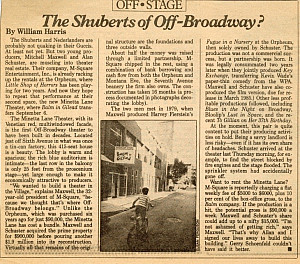18 Minetta Lane: the Modern Downtown.

William B. Harris - Walking Tour
About
William Harris’ visit to 18 Minetta Lane was unusual because he came to review not the play but the building. Now a part of the South Village Historic District, permanent settlement of Minetta Lane dates from the 1820s. Black New Yorkers whose principal source of employment was as labor for white middle- and upper-class families in Greenwich Village settled in smaller older houses along the narrower streets of the Minettas, creating a lively neighborhood that attracted the attention of author Stephen Crane and reformer Jacob A. Riis. In the 1870s Italian immigrants settled in the neighborhood. One, Joseph Di Scala, purchased buildings at 16-22 Minetta, continued to rent the upper floors to Black tenants, and used the ground floors as storage for the rags his co-nationals collected on the streets each day. Di Scala’s businesses ended in 1925, when New York City began extending Sixth Avenue south to Canal Street, ripping the ends off city blocks in the process. Number 18 Minetta survived, but became harder to rent. Meanwhile, a new kind of business came to the Village. In 1952, the theatrical community, using the mechanisms of union contracts (by which workers agreed to accept different rates of pay for large and small theatres) defined “off-Broadway” as a theatre of between 100 and 499 seats (less than 100 seats qualified as “off-off-Broadway.”) Producers and theatrical troupes who calculated they could make a profit in a small theatre venue began seeking out such spaces, and real-estate developers began providing them. In 1978 Alan J. Schuster, an investor raised on his grandfather’s stories about the Second Avenue theatre district, purchased the Orpheum, an old theatre there. In 1982, he, Marin Meit and Mitchell Maxwell, operating as M Square Entertainment, purchased 18 Minetta Street. They renovated it for a theatre and opened it in 1984.